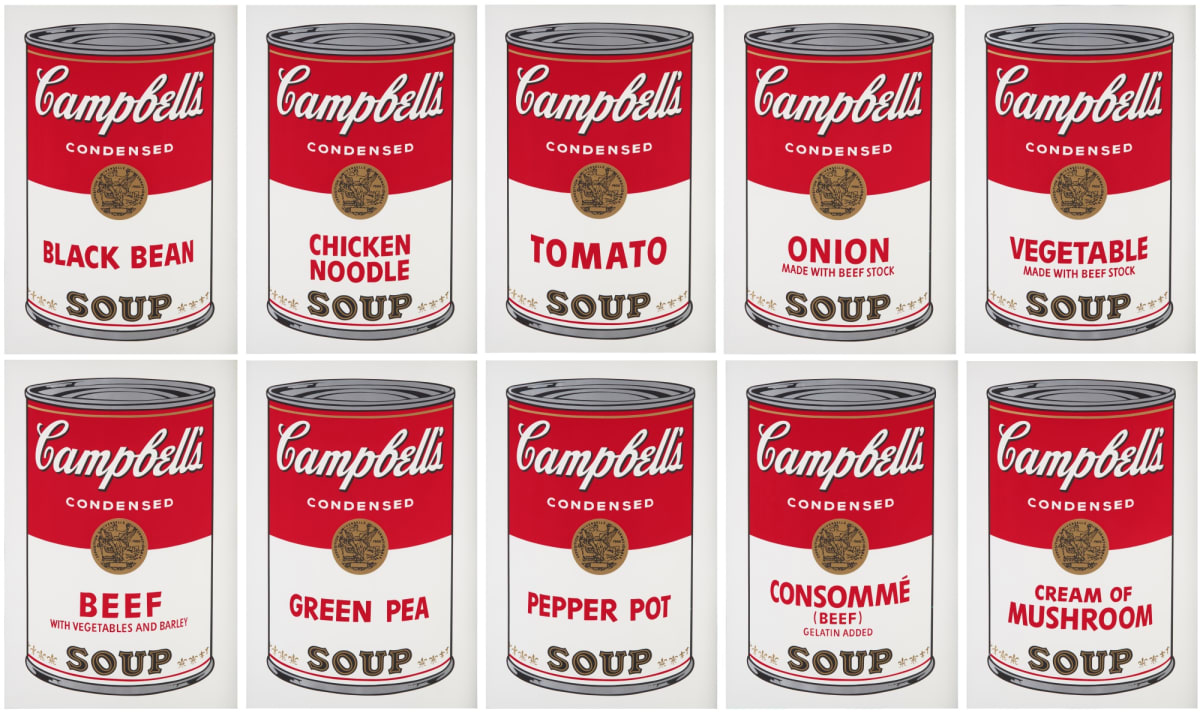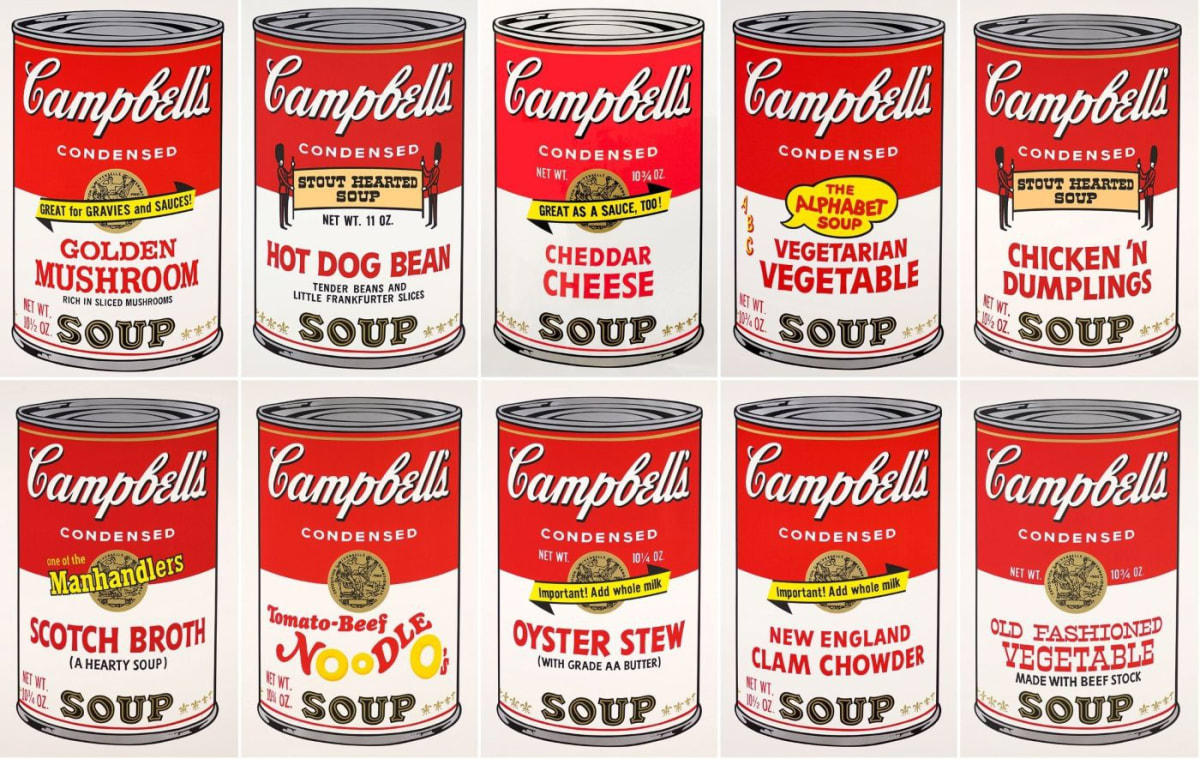
Pop art turned the conventional art world upside down. Instead of traditional subjects such as portraits, landscapes, or historical scenes, Pop artists like Warhol drew inspiration from advertising, comic books, and other elements of popular culture - hence the "Pop" in Pop art. They employed humor and irony to comment on the growing dominance of mass production and consumerism in American life and culture. While the abstract artists of the 1950s, like Jackson Pollock, celebrated their individual creativity, the Pop artists of the 1960s took a different approach. They aimed to eliminate any traces of their artistic process, like brush strokes, to make their work appear almost mechanical, mirroring the mass-produced subjects they depicted.
How did Warhol create his Soup Cans?
However, Warhol's "Campbell's Soup Can" paintings held a paradoxical quality. To create them, Warhol projected the image of a soup can onto a blank canvas, meticulously traced the outlines and details, and filled them in using traditional brushes and paint. For consistency, he employed a hand stamp to add the fleur-de-lys pattern around the base of each label, but there were occasional imperfections. These small details, like the minor splashes of red on the Tomato Soup painting or the unevenly applied fleur-de-lys stamp on others, betrayed the handmade origins of the paintings. In their attempt to resemble mechanical production, Warhol's paintings retained a subtle individuality, not limited to the label's flavour alone.
Why did Warhol paint Soup Cans?
However, there was one consistent alteration across all 32 paintings. Instead of depicting the intricate medallion at the center of Campbell's Soup can labels, which symbolized the "gold medal of excellence" awarded to the company at the 1900 Paris Exposition, Warhol substituted it with a plain gold circle. Biographer Blake Gopnik questioned whether this decision stemmed from technical difficulties or Warhol's preference for the graphic impact of the gold circle.
Two factors contributed to Warhol's choice of Campbell's Soup as his Pop icon: the enduring design of the label, which had changed minimally since its debut at the turn of the 20th century, and Warhol's personal connection to the product. The label's nostalgic, cursive "Campbell's" script closely resembled the signature of the company's founder, Joseph Campbell. Moreover, Warhol had a lifelong relationship with Campbell's soup, stating, "I used to drink it. I used to have the same lunch every day for 20 years."
What did people think of Warhol's Soup Cans?
When Warhol's exhibition opened in 1962, the Pop art movement was still in its infancy, and people struggled to comprehend this departure from traditional art. Irving Blum, one of Ferus Gallery's owners, chose to display the paintings on narrow shelves resembling supermarket aisles, an unconventional installation choice. The response from the public and art critics was generally harsh, with one critic dismissing Warhol as either a naive fool or a shrewd charlatan. A cartoon in the Los Angeles Times mocked the paintings, while an art dealer nearby took the opportunity to ridicule them further by displaying actual cans of Campbell's Soup with a sign that read: "Do Not Be Misled. Get the Original. Our Low Price – Two for 33 Cents."

Despite these initial setbacks, Blum managed to sell five paintings, mainly to friends like actor Dennis Hopper. However, realizing that the paintings were most impactful when displayed as a complete set, he repurchased the ones he had sold from Warhol for $1,000, paid over ten months. This decision proved astute and would yield substantial returns in the future for both the artist and the dealer.
As the public and critics acclimated to the novelty of Warhol's soup cans, they began to appreciate the playful nature of his work. These paintings brought a sense of fun to art, as viewers found it easy to relate to images found in their own kitchens. Critics started recognizing the sly, ironic humor embedded in Warhol's "portraits" of soup varieties. Blum's decision to keep the paintings together further enhanced their impact.
The Ferus Gallery exhibition marked a pivotal moment in Warhol's career. Following the "Campbell's Soup Cans," Warhol shifted from painting to silkscreen printing, a method that produced more mechanical-looking results and allowed him to create multiple versions of a single artwork. His reputation continued to soar, with single soup can paintings from the set not owned by Blum fetching prices as high as $1,500 by 1964. New York socialites even began wearing custom-made paper dresses featuring a soup can print to gallery openings, courtesy of Warhol himself.

What is the impact of the Soup Can paintings?
Campbell's Soups embraced the cultural phenomenon, introducing the "Souper Dress" in the late 1960s—a stylish dress adorned with Warhol-inspired soup labels. These dresses featured three gold bands at the bottom, allowing wearers to adjust the length without compromising the soup can pattern. The price was a mere $1 and two Campbell's Soup labels.
Today, Warhol's soup cans remain iconic in pop culture, gracing various products such as plates, mugs, neckties, t-shirts, surfboards, and skateboard decks. One particularly memorable image featured Warhol himself, as the May 1969 cover of Esquire magazine depicted him submerged in a can of Campbell's Tomato Soup.
Ultimately, Warhol's soup cans earned their place in art history, recognized as museum-worthy by no less than The Museum of Modern Art. In 1996, the museum acquired all 32 paintings from Irving Blum in a gift and sale valued at over $15 million—a staggering return on Blum's $1,000 investment in 1962. Even the "Souper Dress" has gained classic status, finding its home in The Metropolitan Museum of Art's collection in 1995, just a year before the paintings made their way to MoMA. Discover Andy Warhol prints for sale and contact Andipa Editions via sales@andipa.com or call +44 (0)20 7589 2371.
